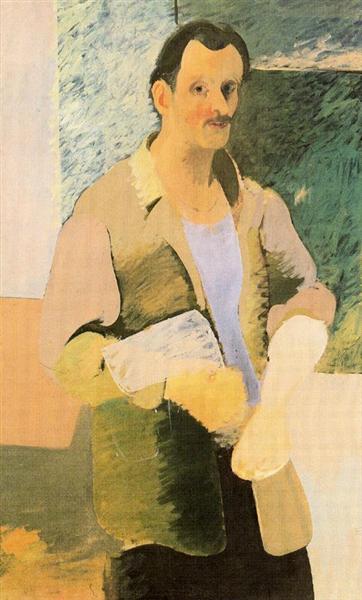Description
The "self -portrait" painting of Arshile Gorky, made in 1937, is a work that encapsulates both the personal experience and the stylistic evolution of its creator within the context of modern art. Gatchy, an Armenian-American painter, stood out for his innovative approach that fuses elements of surrealism, abstract expressionism and biomorphic painting. This self -portrait, in particular, is in a crucial period of his life, marked by the search for his identity and his effort to integrate his cultural heritage into his work.
From the first glance, the composition of the painting suggests a deep sense of introspection. The central figure, which Gorky represents in a stylized and almost spectral way, seems to be surrounded by a dynamic background that interferes with the clarity of its countenance. The contour line of your face is unmistakable, with features that evoke both strength and vulnerability. This contrast can be interpreted as a reflection of its own internal struggles and its desire for belonging in a world that felt alienating.
The use of color in this work is particularly significant. Gorky uses a reduced palette that combines dark tones and terrible nuances, which brings an almost melancholic atmosphere to paint. The colors seem to move between black, deep brown and bluish shadow touches that enclose the figure in a halo of mystery. However, it is not only the choice of colors that highlights, but the way in which they are arranged. The gestural technique, characteristic of Gorky, allows each nuance to reveal an underlying emotion, making this self -portrait a visual manifesto of the artist's psyche.
Through the observation stopped, elements that suggest a connection with surrealism can be found, especially in the representation of the figure that is slightly distorted in an energetic environment. This influence can be associated with their admiration for artists such as André Masson and Joan Miró, who explored dreams of dreams and subconsciousness in their work. In "Self -portrait", Gorky manages to intertwine these influences with his own experience, offering a visual interpretation of his emotional state and his relationship with a changing world in the 1930s.
It is essential to remember that Gorky worked in a period in which abstraction began to prevail in art, but his self -portrait approach moves away from simple physical representation, getting closer to an emotional and spiritual approach. This is aligned with their other works of the time, which also explore abstraction in relation to the human figure and the nature of existence. Compared to other contemporary self -portraits, Gorky's stands out not only for his technique and style, but for the intense emotion that emanates from the work.
The "self -portrait" of 1937 is not merely a representation of its physiognomy; It is a symbol of his continuity as an artist and his struggle to find his place both in the world of art and in the American cultural space. Through this work, Gorky invites the viewer to a reflection on identity, memory and personal experience. The result is a piece that not only documes its image, but also acts as a powerful testimony of its character and its legacy in the panorama of modern art. Gorky, having lived and experienced the turbulence of the twentieth century, through his art, offers us a window to the complexity of his being and his unique perspective in the world.
KUADROS ©, a famous paint on your wall.
Hand-made oil painting reproductions, with the quality of professional artists and the distinctive seal of KUADROS ©.
Art reproduction service with satisfaction guarantee. If you are not completely satisfied with the replica of your painting, we refund your money 100%.

